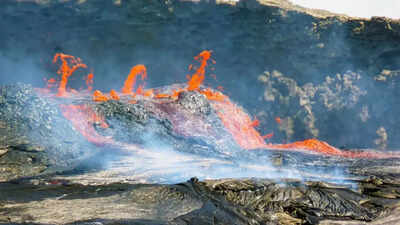In the Afar Depression of East Africa, a unique geological hotspot where three tectonic plates converge, scientists have discovered new evidence that magma from the Earth's mantle is contributing to the continent's gradual splitting. Studies indicate that mantle upwellings beneath the region are not uniform but rise in complex waves, fueling volcanic eruptions and seismic activity, and weakening the Earth’s crust. This ongoing process is expected to lead to the formation of a new ocean, separating the Horn of Africa and dramatically reshaping the region's geography.

The image captures ongoing volcanic activity in the Afar region.
Researchers from the University of Southampton and Swansea University analyzed lava samples from over 130 volcanoes in the Afar region. Their analysis revealed that the mantle beneath East Africa exhibits a rhythmic behavior, with pulses of molten rock rising to the surface. Each pulse has a unique chemical signature, suggesting that the mantle consists of different materials. This dynamic behavior is influenced by the thickness and movement of the tectonic plates above.
In areas with rapid movement, such as the Red Sea Rift, the mantle flow is more concentrated. In regions with slower rifting, it spreads out more gradually. These pulses pass through thinned areas of the Earth's crust, increasing the likelihood of volcanic eruptions. The chemical "striping" in the lava mirrors cardiovascular rhythms, reflecting the Earth's internal tempo. This offers insights into how surface volcanic activity connects to processes occurring far beneath the surface.
The plume's activity is also eroding the lithosphere, the Earth's outer shell, down to just 15 kilometers thick in certain parts of the Afar Depression. As the plates continue to stretch and thin, they create pathways for more lava to reach the surface, causing repeated cycles of volcanic eruptions and seismic activity. This mirrors processes that occurred during the formation of the Atlantic Ocean millions of years ago.
The geological activity in the Afar region is part of a larger process known as continental rifting. The African, Arabian, and Somali tectonic plates are moving apart, and the space between them is filling with magma and new crust. As this rifting continues, seawater is expected to flood the region, creating a new ocean basin, similar to the Atlantic Ocean.
The ongoing volcanic eruptions are already reshaping the surface. Lava from the Erta Ale volcano covers large parts of Ethiopia, and frequent earthquake swarms indicate areas of intense tectonic stress. The Boset Volcano shows layers of volcanic deposits, illustrating the long-term effects of the mantle’s upwelling.
These findings provide a glimpse into the birth of an ocean and offer insights into Earth's climate and history. Past mantle plumes have created massive volcanic provinces, such as the North Atlantic Igneous Province, which contributed to climate changes and potentially mass extinctions through the release of CO₂ and sulfur dioxide.
Scientists emphasize the importance of collaboration across institutions and disciplines to understand these complex dynamics. Future research will focus on mapping mantle flows beneath other thinning tectonic plates and predicting how these deep forces shape the surface geology. The Afar region serves as a natural laboratory for observing the connection between Earth's interior and its evolving surface.
Newer articles
 Bezos-Backed Methane-Tracking Satellite Mission Ends Abruptly After Loss of Contact
Bezos-Backed Methane-Tracking Satellite Mission Ends Abruptly After Loss of Contact
 Africa's Rift Valley: Mantle Upwelling Fuels Volcanic Activity, Foretelling New Ocean Birth
Africa's Rift Valley: Mantle Upwelling Fuels Volcanic Activity, Foretelling New Ocean Birth
 7 Proven Habits to Nail Your Next Job Interview: Project Confidence and Authenticity
7 Proven Habits to Nail Your Next Job Interview: Project Confidence and Authenticity
 Smith Targets Test Return After Innovative Baseball Cage Rehab in New York
Smith Targets Test Return After Innovative Baseball Cage Rehab in New York
 5 Subtle Signs of Prediabetes You Shouldn't Ignore
5 Subtle Signs of Prediabetes You Shouldn't Ignore
 Oral Cancer: Know the Warning Signs, Risk Factors, and Why Early Detection is Key to Survival
Oral Cancer: Know the Warning Signs, Risk Factors, and Why Early Detection is Key to Survival
 Hair Oil vs. Serum: Which Elixir is Right for Your Hair Type? A Comprehensive Guide
Hair Oil vs. Serum: Which Elixir is Right for Your Hair Type? A Comprehensive Guide
 Blackcaps and White Ferns Face Packed Home Summer Against Cricket Heavyweights
Blackcaps and White Ferns Face Packed Home Summer Against Cricket Heavyweights
 Gambhir Defends India's Tailenders After Headingley Collapse; Cites Dropped Catches as Key Factor in Test Loss
Gambhir Defends India's Tailenders After Headingley Collapse; Cites Dropped Catches as Key Factor in Test Loss
 England Captain Stokes Lauds Duckett and Crawley for Blistering Start in Record Chase Against India
England Captain Stokes Lauds Duckett and Crawley for Blistering Start in Record Chase Against India